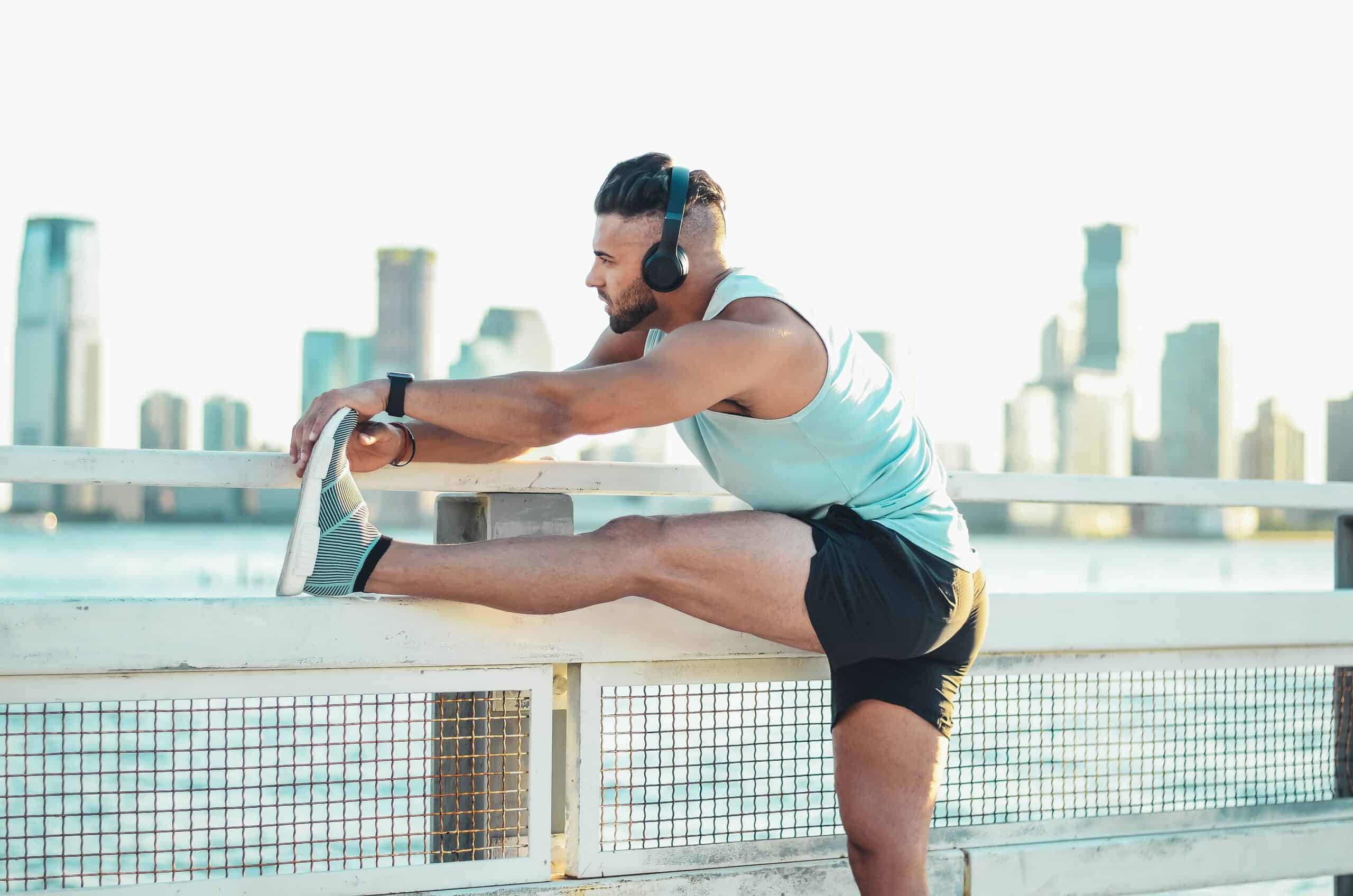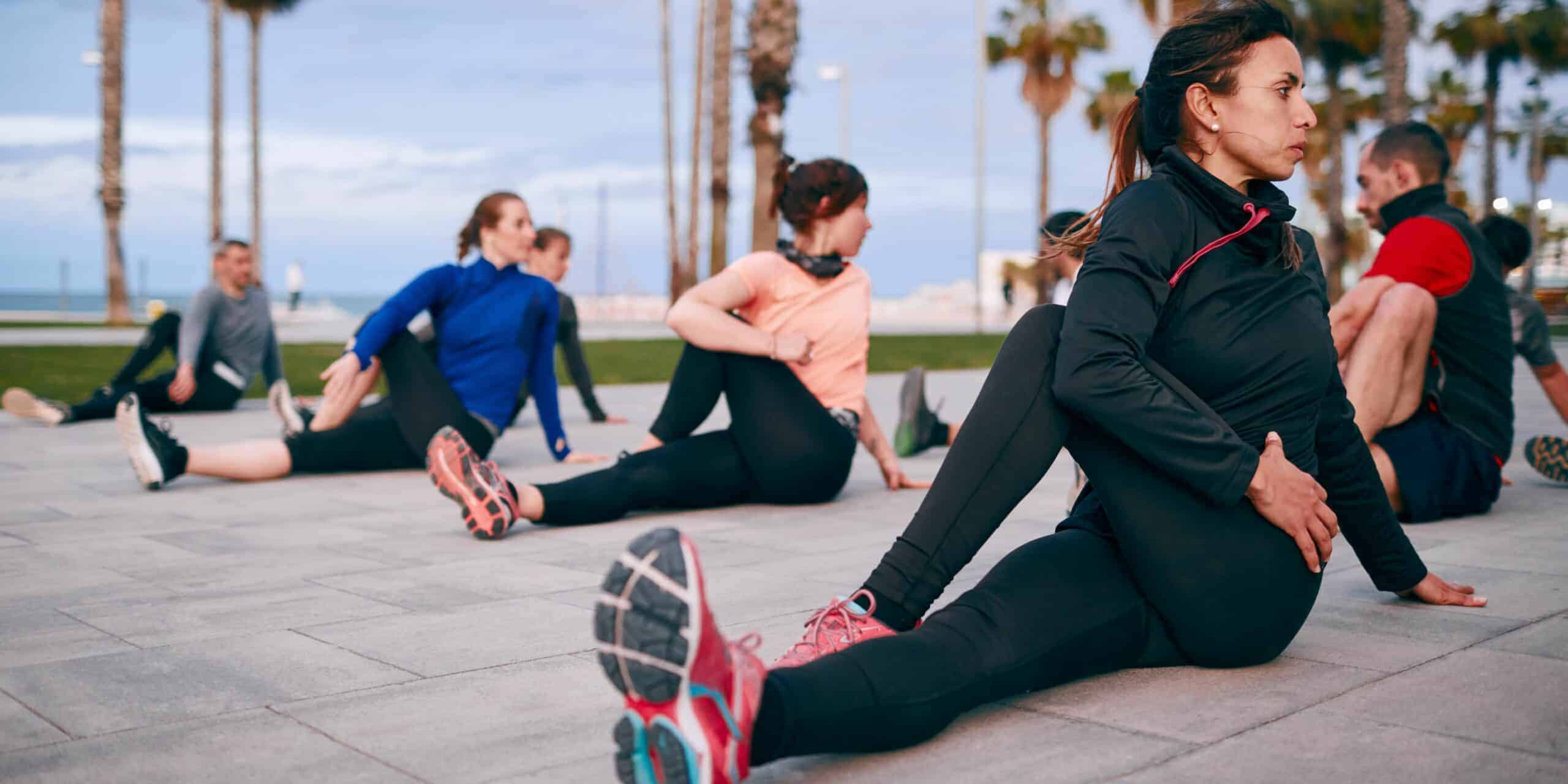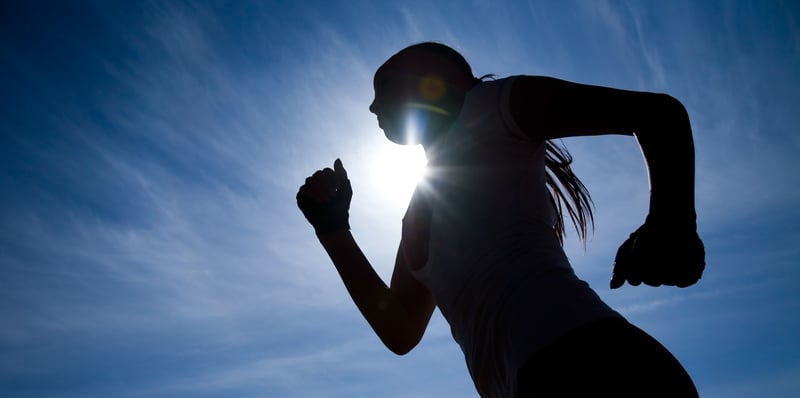
Stretching before and after your run can reduce the risk of injuries and help you perform your best. While it does mean tacking on more time to your workout, stretching should be considered essential to any workout regiment. Reap the benefits of every run by building and committing to a stretching routine. This article will help you find the best stretches for runners.
What Are the Benefits of Stretching?
The benefits of stretching for runners range from improved blood flow and circulation to injury prevention. Here’s a look at the top benefits you can experience when completing essential stretches:
- Injury prevention
- Increased blood flow to your muscles
- Less muscle tension
- Greater range of motion
- Decreased post-run soreness
- Strength building
- Decreased likelihood of muscle cramps
- Improved running performance
Static Stretching vs. Dynamic Stretching
There are two types of stretching: static and dynamic. Each has its benefits.
Dynamic stretching helps prepare a body for exercise. It mimics what happens in a body during a workout within a normal range of motion. A dynamic stretch routine before running might include lunges, butt kicks and body-weight squats.
Static stretching requires holding a position for a prolonged period. The muscles are pushed beyond their normal range of motion. Static stretching is recommended mostly for post-workout routines.
When Should I Stretch?
You should use a mix of dynamic and static stretches before and after your runs for the best results. A safe, healthy running routine might look something like this.
- Warm up with a gentle jog for five minutes. Or if you’d prefer, you can do another form of cardio likeas a stationary bike.
- Do five minutes of dynamic stretching to activate the muscles and ligaments needed for the best run performance.
- Complete your planned workout. Be sure you’re following a solid run training plan that mixes intervals, tempo, long, and recovery runs for the best results.
- Spend five minutes cooling down with light cardio — preferably by walking or light jogging.
- Finish your workout with static stretching. Commit to at least five minutes post-workout for best results. This will help you cool down while improving flexibility and limiting muscle soreness. Incorporate a stretch on each of the muscle groups involved in running – calves, quads, hamstrings, hips and feet.
10 Essential Stretches for Every Type of Runner
Whether you’re new to running or a seasoned athlete, integrating running stretches and into your routines will give you the best results from your workout. Below are the best stretches for runners.
1. Standing Quad Stretch
Your quads offer power, stability, and speed while running. Because of this, it’s important to perform quad stretches for runners before and after your runs.
- Find a wall or sturdy object you can use for support.
- Standing upright, bring your heel up toward your glutes.
- Grab your ankle with your hands and gently pull your leg upward.
- Drive your knee toward the floor and feel the stretch through your upper thigh (quads).
- Hold for 30 to 60 seconds.
- Repeat on the other leg.
2. Seated Hamstring Stretch
Your hamstrings can get tight after a run, no matter the distance. If you allow your hamstrings to stay tight, you could end up with back pain as the back would need to compensate for the lack of stabilizing support from the legs.
- Take a seat on the floor.
- Sit with one leg extended and the other leg folded in with your foot resting near your mid-thigh.
- Keep your back straight.
- Reach both arms toward your toes or ankle while keeping your knee straight but not strained.
- Lean into the stretch with your upper body to feel its full effects.
- You should feel the stretch in the backside of your upper thigh.
- Hold the stretch for 30 to 60 seconds.
- Repeat on the other leg.
3. Lying Glute Stretch

While you’re on the ground, stretch your glutes. A common ailment runners face is piriformis syndrome. This happens when the piriformis muscle tightens. It causes pain in the buttock and can radiate down the sciatic nerve, impacting the back and thigh. This is one of the best stretches for runners.
- Lie on the floor with your feet out.
- Bring your knee toward your core.
- Grasp your knee with both hands and pull it toward your body gently.
- Feel the stretch through your buttock.
- Hold for 30 to 60 seconds.
- Repeat using the other leg.
4. Seated Groin Stretch
Six muscles make up the groin area, and they get a serious workout during runs. Your groin muscles connect to your pubic bone and inner thighs. They help support your knees, making them extremely important for healthy running.
- Sit on the floor.
- Place the soles of your feet together, allowing your knees to go outward.
- Gently allow your knees to fall toward the floor.
- Keep your back straight.
- To intensify the stretch, bring your heels closer to your body but be careful to not overdo this stretch.
- Hold for 30 to 60 seconds with your knees down toward the floor.
5. Runner’s Stretch for Lower Calves
The runner’s stretch is also sometimes called a wall push. This stretch helps loosen up your lower calves. During running, the calves maintain your body’s alignment and ensure your gait is in check. Strong, flexible calves prevent knee injuries and ease low back pain.
- Stand about a foot from a wall.
- Place one foot a few feet behind you as if you were about to do a lunge.
- Bend your front knee and keep your back leg straight but not strained.
- Lean your hips backward as you bend your forward leg.
- You should feel a good stretch through your lower calf in the bent leg that is in the front.
- Hold the stretch for 30 to 60 seconds.
- Switch legs and repeat.
6. Upright Iliotibial Band Stretch
The iliotibial (IT) band is a large muscle that runs down your hip into your shin. When dealing with IT band syndrome, runners experience pain on the outside of their knees. Recovering from an IT band injury can take weeks or months. To stretch your IT band, use this upright stretch.
- Stand near a wall or tall object you can use to steady yourself if needed.
- Cross your left ankle in front of your right with your feet close together.
- Take your left arm and stretch it over your head while stretching to your right.
- Hold the stretch for 30 to 60 seconds.
- Repeat on the other side of your body.
7. Adductor Side Lunge Stretch
Adductor muscles are part of the thigh and help bring your leg toward the center of your body. Strong, flexible adductors provide the most efficient running while stabilizing your body. You can stretch your adductor using an upright lunge movement.
- Stand with your feet spread in a wide stance.
- Keep your right leg stationary.
- Lean outward to the left and bend your left knee until you feel a stretch.
- Place both hands just above your left knee.
- Hold for 30 to 60 seconds.
- Repeat on the other leg.
8. Lying Down Spine Stretch
The lower body gets all the attention when running. But your back works hard to support your body, too. Stretching your low back will feel great and improve mobility. Plus, if you spend too much time sitting throughout the day, this spine stretch will help keep muscles loose and agile.
- Lie on your back with your arms stretched out at your sides.
- Bend your knees up toward the ceiling.
- Slowly and gently allow your knees to fall toward the floor while keeping your shoulders and arms firmly planted on the ground.
- Only drop your knees until you feel the stretch. Don’t push your knees to the ground if that’s too much for your low back.
- Hold for 30 to 60 seconds.
- Repeat by dropping your knees to the other side of your body.
9. Seated Shin Stretch
One of the most dreaded injuries for runners is shin splints. While wearing the wrong shoes or worn-out shoes are common culprits for this injury, stretching can help prevent shin splints and reduce discomfort from running on hard surfaces. Here’s how to stretch your shins after a workout.
- Kneel on the floor.
- Lower your buttocks down onto your heels.
- Lean backward and support your body with your arms behind you.
- Hold for 30 to 60 seconds.
10. Hip Flexor Lunge Stretch
Hip flexors help with forward propulsion during running. If your hips are too tight, you’ll have limited mobility and won’t be able to run as fast. You can stretch your hip flexors in a lunge pose.
- Assume a lunge position with your left leg in front of you with a 90-degree bend in your left knee.
- Place your right leg directly under your body.
- Keep your back straight and your arms at your side or on your hips.
- Shift your body forward while keeping your upper body straight.
- Hold the stretch for 30 to 60 seconds.
- Repeat on the other side.
Stretching Tips: Dos and Don’ts
Starting a stretching routine will take some time and practice. Review these stretching tips with dos and don’ts for best results.
Do
- Match the type of stretch to the phase of your workout — static or dynamic.
- Stretch gently.
- Give stretching the time it deserves.
- Complete each stretch three to five times for best results.
- Stretch after every workout.
- Hold static stretches for 30 to 60 seconds.
Don’t
- Push yourself too hard or force a stretch to the point where it hurts.
- Complete the same stretch repeatedly. For the best flexibility, you want to vary your stretches.
- Keep your limbs straight while stretching. You should have some bend to your arms and legs or you could suffer an injury.
- Skip stretching and reallocate the time to running more. This is a good way to get hurt.
Preventing Injuries and Improving Mobility Through Stretching Routines
The best way to prevent running injuries is to build an effective stretching routine and commit the time to maintain the routine. Keeping muscles loose will also help improve your mobility, which means faster run times and easier long runs. Test out the stretches above and start rotating through them post-workout to feel the difference.
FAQ
You should complete dynamic stretches before running and static stretches after running for the best results.
Stretching helps runners prevent injury, improve flexibility and build strength.
Stretching can help you get faster by loosening up your muscles, preventing cramping and building more strength. But you’ll need to use stretching in combination with an effective run training plan.





